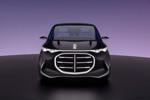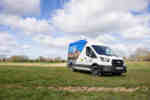Indeed, the term 'supermini' may no longer be appropriate for B-sector cars like the next generation Ford Fiesta, Volkswagen Polo and Citroen C3 - all to be launched at the German event.
They might be better described as 'small family cars', offering a greater range of features and as much interior space as many C-sector cars just a few years ago.
For the company car sector, the new breed of supermini is nothing short of revolutionary - particularly as fuel efficiency, emission levels and environmental-friendliness become ever more important to fleet buyers.
The fourth generation VW Polo features a new body, new engines and many technological improvements.
Significantly, it's 154mm longer than its predecessor, with a 53mm longer wheelbase. That improves interior packaging, handling and ride.
Aside from the Lupo-like nose, the new Polo borrows many of its design cues from the Golf - and in so doing further encroaches on the market territory of its larger stablemate.
'With its new size, the Polo meets all the needs of both a family car and a quality urban car,' said a Volkswagen spokesman. 'It will move the small car benchmarks of quality and safety to a new level.'
Optional equipment includes electronic stability program (ESP), a hydraulic brake assistant (HBA), both designed to improve safety. Standard specification will include driver, passenger and side airbags, as well as ABS (anti-lock brakes). Such features were available only on luxury cars until recently.
But Ford will be challenging Volkswagen for the spotlight in Frankfurt - the new Fiesta will be a formidable competitor in the European B-segment. Looking just like a compact version of the larger Focus, the new Fiesta is targeted directly at the fleet sector with a powerful variety of body styles, engines and specifications.
Alongside standard versions of the car, a Fiesta-based sport-utility-style vehicle will also be shown in concept form. This car - rumoured to be called the Urban Activity Vehicle - will go on sale in Europe at the end of next year. It's a clear sign that Ford wants to offer a greater breadth of niche cars based on each model family.
The UAV has no direct rivals on the market at present - perhaps the Mitsubishi Shogun Pinin is closest in concept - but the supermini-based recreational sector is expected to grow quickly over the next few years. Peugeot is also looking at the sector with a 206-based car.
These are not pure off-road vehicles: the Fiesta UAV is limited to front-wheel drive. Rather Ford sees it as a lifestyle car that will appeal to young, sporty drivers as well as families who are looking for something different.
But for most fleets it will be the mature, cleanly-styled Fiesta five- and three-door models that will appeal. The three-door is not expected to arrive for a while yet - so only five-door models will be on show at Frankfurt.
They'll be powered by 1.25-, 1.3-, 1.4- and 1.6-litre petrol engines, and two state-of-the-art diesels - something Ford has lacked in recent years.
The current Fiesta has always been hampered by its cramped interior - largely because it is based on a model launched a decade ago.
Even though it's now a much better car to drive than it was a few years ago, it has fallen behind crucial competitors like the Peugeot 206, Renault Clio and Skoda Fabia.
The new Fiesta is about 9cm longer than the car it replaces, and almost 10cm taller. Ford said the structural changes were designed to give it the best interior space in its class.
Meanwhile Citroen's long-awaited C3 will also appear at Frankfurt. Like the Fiesta, Micra and Polo, the C3 will stun owners of cars like the unremarkable Saxo with its individuality, a longer wheelbase, greater interior room and much-improved crash-protection levels.
The C3 will be the tallest car in its class. Citroen does not see it as a direct replacement for the aging Saxo, but rather as a car that will fit in between the Saxo and Xsara ranges.
However, the C3 will inevitably compete against cars like the new Fiesta and Polo. The C3 marks a hugely important landmark in Citroen's strategy to return to making characterful cars once again.
During the 1990s the French manufacturer was criticised for its capable but dull cars that ignored the company's innovative history. This was particularly true in the supermini segment, where the Saxo struggled against better competitors.
Elsewhere, one of the stars of the Nissan stand will be a concept that previews the future replacement for the Micra. Called the mm.e, this supermini concept also points to new levels of comfort and technology in such a lowly segment of the market.
'The internet and communications technology, advanced navigation and audio systems are all integrated into a computer-controlled central display that can be commanded directly, or through a remote control mounted on the steering wheel,' said a Nissan spokesman.
'In response to emerging trends in this segment, which show a need for increased levels of perceived quality and in-car comfort and enjoyment, mm.e also features some innovative interior materials.'
The full 2002 Micra replacement will be a crucial car for Nissan - particularly in the European fleet market, where the Japanese manufacturer is determined to strengthen its performance.
The Micra will share a platform with the next Renault Clio - the first shared project to benefit from the industrial link-up between the two companies. It will be built at Nissan's Sunderland, UK, plant.
The Micra and Clio will also share some engines, although the body shells will be different.
Honda's new small car, the Jazz, also makes its debut at Frankfurt. 'Fleet buyers will be able to see how Honda has created the small car with the most room - and one that offers the highest levels of safety, practicality and fuel efficiency,” said a Honda spokesman. (September 2001)
















Login to comment
Comments
No comments have been made yet.